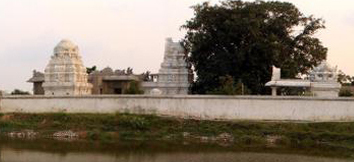- Shiva
Shree Agneeswarar Temple
- Neyveli,Tamil Nadu
- View on map
- Tell us about this temple
It is believed that wherever Lord Shiva is being worshipped by rishis and siddhars everyday, the main deity there is Shree Agneeswarar. Legend has it that the 18 siddha purushas, featured among whom are the two most prominent ones, Shree Karur Devar and Nerur Shree Sadhasiva Brahmendrar, worship this deity even today at midnight. The Kallala tree, without hanging roots is the abode of Vana Durga, who is Mother Kali, the Goddess of forests. Nine rishis are doing penance below this tree. Prasnam revealed that the Adivasis that lived in the forest worshipped Mother Kali in this form as their main deity in the ancient days. The divine presence of Kali is still felt even today, in this tree. A serpent couple which lives in the tree make occasional appearances during the pradhosha kaala poojas even today. The surrounding area of Poondy is historically a place where ancient Stone Age people lived, especially since they lived near the water bodies. The Gudiyam caves near Poondy have pre-historic caves where people in the Stone Age people lived. On the way to Neyveli from Poondy, the vast area on the right hand side has been fenced and is now being protected by the Archeological Survey of India. There is a permanent museum curating all the findings and discoveries of the people in the Stone Age. The Agni Theertham pond, situated in the North Eastern part of the temple, is believed to have come up from the third eye of Eshwara. A dip in this holy tank and the worship of Eshwara is sure to eliminate the severest kind of Sarpa dhosha. This temple will be a popular pilgrimage centre very soon as people from all over this country and abroad will throng the place to have a glimpse of Shree Agneeswarar. The temple has a similar spiritual significance to that of Kalahasthi for the Sarpa dhosha remedy. Shri Agneeswarar sits in an ancient hutment with the damaged walls on all sides. There are traces of this having been a good structure once upon a time. The Kallala tree had grown into the shrine and engulfed the Agneeswarar from all sides. We can visualize that the roots of the tree from all sides and the damaged old roof had stood as a solid protection for Shri Agneeswarar during all these years. There is a space that can hold only about 3-4 people to stand in front of the sanctum. There is a serpent cave in the tree in such a position that when people stand, the serpent can be present just a few inches back of their head and watch the proceedings.
Significance
Devotees visit this temple to seek fulfillment of the following:-
- To eliminate the severest kind of Sarpa dhosha
Shlokas
Kailaasarana Shiva Chandramouli Phaneendra Maathaa Mukutee Zalaalee Kaarunya Sindhu Bhava Dukha Haaree Thujaveena Shambho Maja Kona Taaree
Meaning -Oh Lord Shiva who is seated on Mount Kailash, where the moon decorates his forehead and the king of serpents crown his head, who is merciful and removes delusion, You alone can protect me. I surrender to thee.
Aum Trayambakam Yajaamahey Sugandhim Pusti Vardhanam Urvaarukamiva Bandhanaath Mrutyor Muksheeya Maamritaat
Meaning -We worship the fragrant Lord Shiva, who has 3 eyes and who cultivates all beings. May He free me from death, for immortality, as even a cucumber is separated from its bond with the vine.
